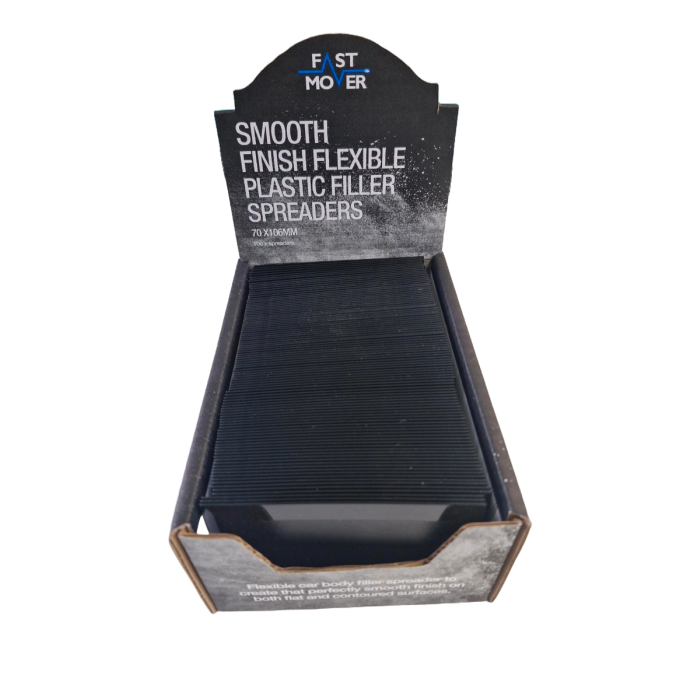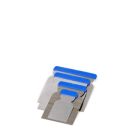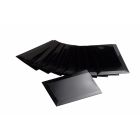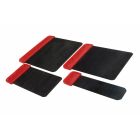|
Why use a plastic body filler spreaders - plain black
|
|
|
|
|
|
1. Flexible Yet Firm
|
|
|
|
|
|
Black plastic spreaders are typically made from flexible yet sturdy plastic.
|
|
|
|
|
|
They conform slightly to surfaces, allowing smooth, even application over curves and flat panels.
|
|
|
|
|
|
|
|
|
|
|
|
2. Non-Absorbent Surface
|
|
|
|
|
|
Plastic does not absorb filler material, so it:
|
|
|
|
|
|
|
|
|
|
|
|
Doesn’t waste product
|
|
|
|
|
|
Minimizes clogging or buildup
|
|
|
|
|
|
Allows easier cleaning and reuse
|
|
|
|
|
|
|
|
|
|
|
|
3. Clean Finish
|
|
|
|
|
|
Smooth edge design provides a streak-free, uniform application.
|
|
|
|
|
|
Ideal for leveling automotive body filler, polyester putty, or glazing putty.
|
|
|
|
|
|
|
|
|
|
|
|
4. Cost-Effective
|
|
|
|
|
|
These spreaders are low-cost, disposable if needed, or reusable with proper cleaning.
|
|
|
|
|
|
Great for both professionals and DIY users.
|
|
|
|
|
|
|
|
|
|
|
|
5. Multiple Sizes and Versatility
|
|
|
|
|
|
Usually sold in sets with different widths (e.g., 50mm, 75mm, 100mm).
|
|
|
|
|
|
Suitable for small dents, large panels, or tight areas.
|
|
|
|
|
|
|
|
|
|
|
|
6. Safe for Surfaces
|
|
|
|
|
|
Won’t scratch metal, primer, or fiberglass surfaces.
|
|
|
|
|
|
Preferred in refinishing and bodywork for surface-sensitive jobs.
|
|
|
|
|
|
|
|
|
|
|
|
7. Black Color Advantage (Plain Black)
|
|
|
|
|
|
The plain black color:
|
|
|
|
|
|
|
|
|
|
|
|
Reduces visual distraction when working with light-colored fillers.
|
|
|
|
|
|
Makes leftover filler more visible during cleanup.
|
|
|
|
|
|
Often indicates a general-purpose, durable grade.
|
|
|
|
|
|
|
|
|
|
|
|
Common Uses
|
|
|
|
|
|
Application
|
Material Used
|
|
Auto body repair
|
Body filler (Bondo), putty
|
|
Construction patching
|
Joint compound, plaster, filler
|
|
Marine or fiberglass work
|
Resin filler, gelcoat repair compound
|
|
DIY repair
|
Wall filler, spackling paste
|
|
|
|
|
|
|
|
The benefits of a plastic body filler spreaders - plain black
|
|
|
|
|
|
1. Smooth and Even Application
|
|
|
|
|
|
Designed with a flexible edge to spread body filler, putty, or compound evenly across surfaces.
|
|
|
|
|
|
Reduces air bubbles and helps achieve a professional, flat finish.
|
|
|
|
|
|
|
|
|
|
|
|
2. Flexible but Durable
|
|
|
|
|
|
Made from durable yet flexible plastic, allowing the spreader to conform to curves or contours in body panels or surfaces.
|
|
|
|
|
|
Doesn’t crack or snap easily under normal use.
|
|
|
|
|
|
|
|
|
|
|
|
3. Non-Stick Surface
|
|
|
|
|
|
The plastic surface minimizes filler adhesion, making it easy to clean and reuse.
|
|
|
|
|
|
Prevents wasted material and buildup, which can affect the finish.
|
|
|
|
|
|
|
|
|
|
|
|
4. Cost-Effective
|
|
|
|
|
|
Inexpensive and widely available.
|
|
|
|
|
|
Can be used multiple times or disposed of when worn out or after single-use messy jobs.
|
|
|
|
|
|
|
|
|
|
|
|
5. Variety of Sizes
|
|
|
|
|
|
Often sold in sets of various widths (e.g., 50mm, 75mm, 100mm) to suit different job sizes and shapes.
|
|
|
|
|
|
Helps apply filler in tight areas or over large panels.
|
|
|
|
|
|
|
|
|
|
|
|
6. Plain Black Color Advantages
|
|
|
|
|
|
Plain black finish:
|
|
|
|
|
|
|
|
|
|
|
|
Makes residual filler more visible, so it's easier to clean.
|
|
|
|
|
|
Looks professional and blends into toolkits.
|
|
|
|
|
|
Typically used for general-purpose, high-durability spreaders.
|
|
|
|
|
|
|
|
|
|
|
|
7. Surface-Safe
|
|
|
|
|
|
Won’t scratch or damage paint, primer, fiberglass, or bare metal.
|
|
|
|
|
|
Preferred in automotive refinishing for delicate body panels.
|
|
|
|
|
|
|
|
|
|
|
|
8. Ergonomic and Lightweight
|
|
|
|
|
|
Easy to handle, especially during long jobs.
|
|
|
|
|
|
Reduces fatigue and improves application control.
|
|
|
|
|
|
|
|
|
Uses and applications of a plastic body filler spreaders - plain black
|
|
|
|
|
|
1. Automotive Body Repair
|
|
|
|
|
|
Applying body filler (e.g., Bondo) to dents, scratches, and panel damage.
|
|
|
|
|
|
Spreading putty over weld seams, joints, or patch repairs.
|
|
|
|
|
|
Shaping and leveling filler before sanding and priming.
|
|
|
|
|
|
Used for both minor touch-ups and major collision repairs.
|
|
|
|
|
|
|
|
|
|
|
|
2. Construction and Wall Repair
|
|
|
|
|
|
Filling holes, cracks, and gaps in drywall, plaster, or concrete.
|
|
|
|
|
|
Applying joint compound or spackle during drywall installation and finishing.
|
|
|
|
|
|
Smoothing out patching compound on interior and exterior surfaces.
|
|
|
|
|
|
|
|
|
|
|
|
3. Marine and Fiberglass Work
|
|
|
|
|
|
Spreading gelcoat fillers, epoxy, or polyester resins for boat or fiberglass repair.
|
|
|
|
|
|
Conforming to curved surfaces on hulls or panels.
|
|
|
|
|
|
|
|
|
|
|
|
4. Woodworking and Furniture Repair
|
|
|
|
|
|
Applying wood filler or epoxy to cracks, gouges, or seams.
|
|
|
|
|
|
Smoothing filler before sanding and finishing.
|
|
|
|
|
|
|
|
|
|
|
|
5. DIY and Home Maintenance
|
|
|
|
|
|
Quick repairs on walls, furniture, or exterior siding.
|
|
|
|
|
|
Spreading and shaping sealants, adhesives, or patching pastes.
|
|
|
|
|
|
|
|
|
|
|
|
6. Painting Preparation
|
|
|
|
|
|
Used in surface prep to fill imperfections before painting.
|
|
|
|
|
|
Helps create a smooth, paint-ready surface.
|
|
|
|
|
|
|
|
|
|
|
|
7. Tiling and Grouting (Occasional Use)
|
|
|
|
|
|
Can be used to apply grout or filler in tight or shallow areas as a substitute for grout floats (though not the primary tool for this).
|
|






